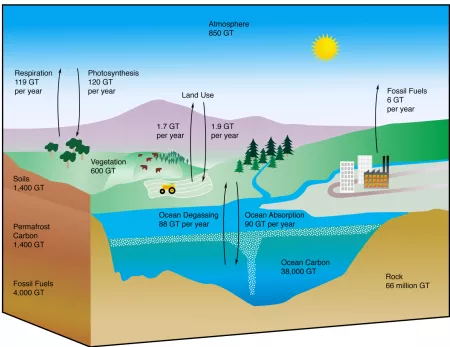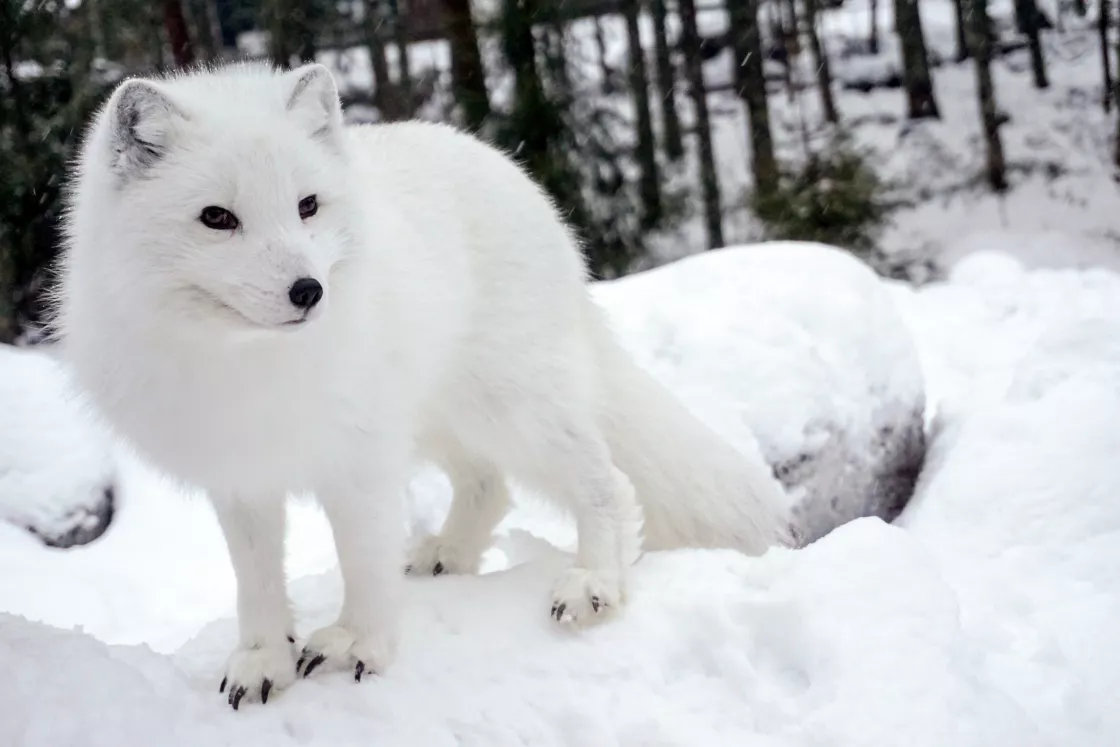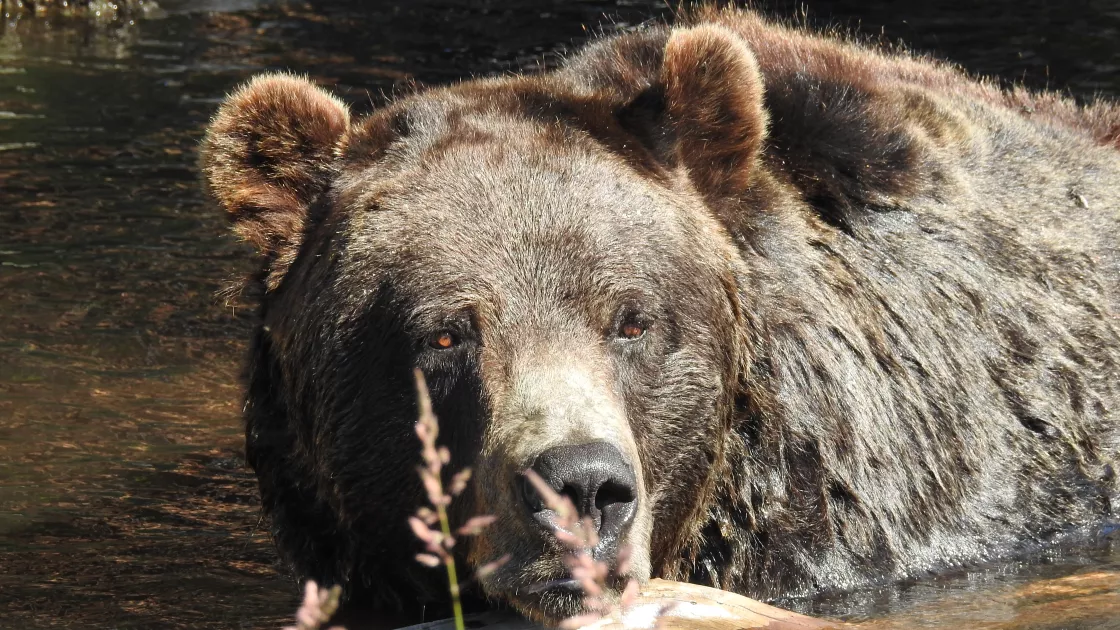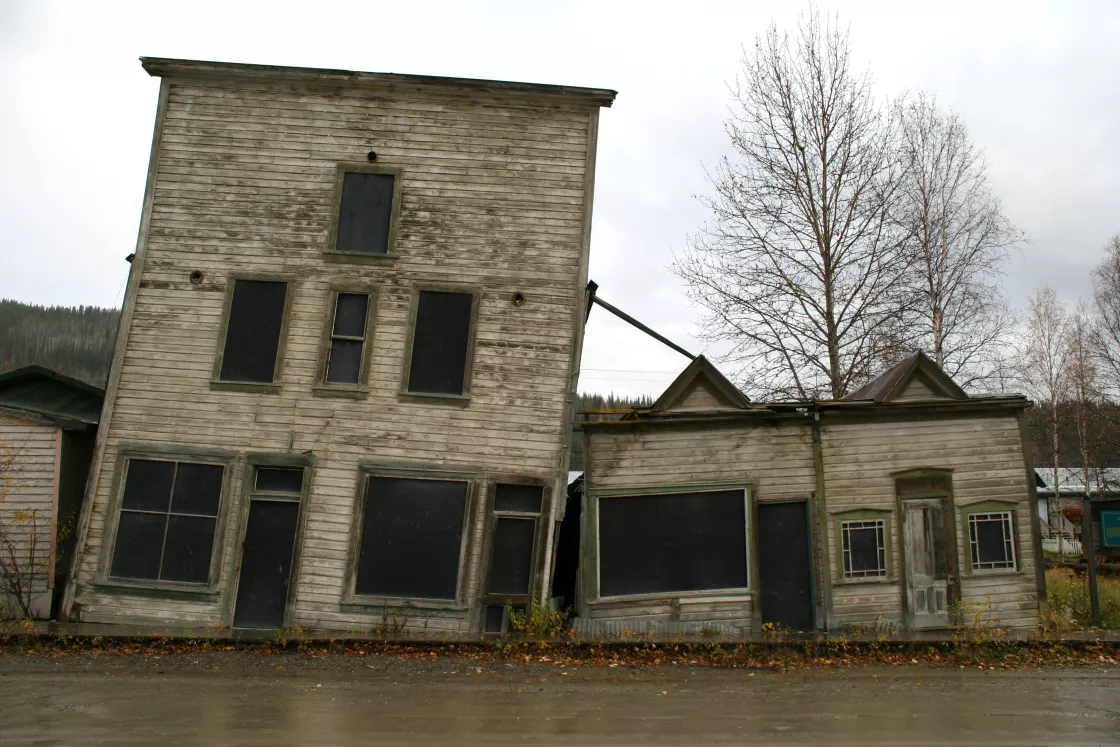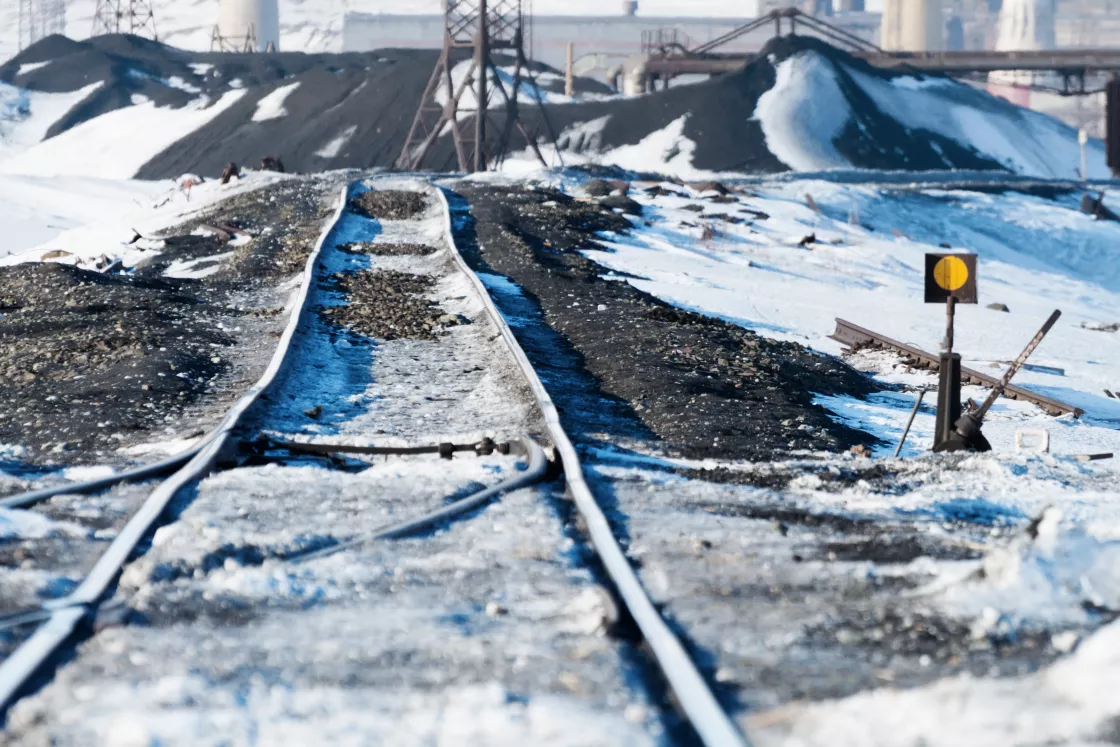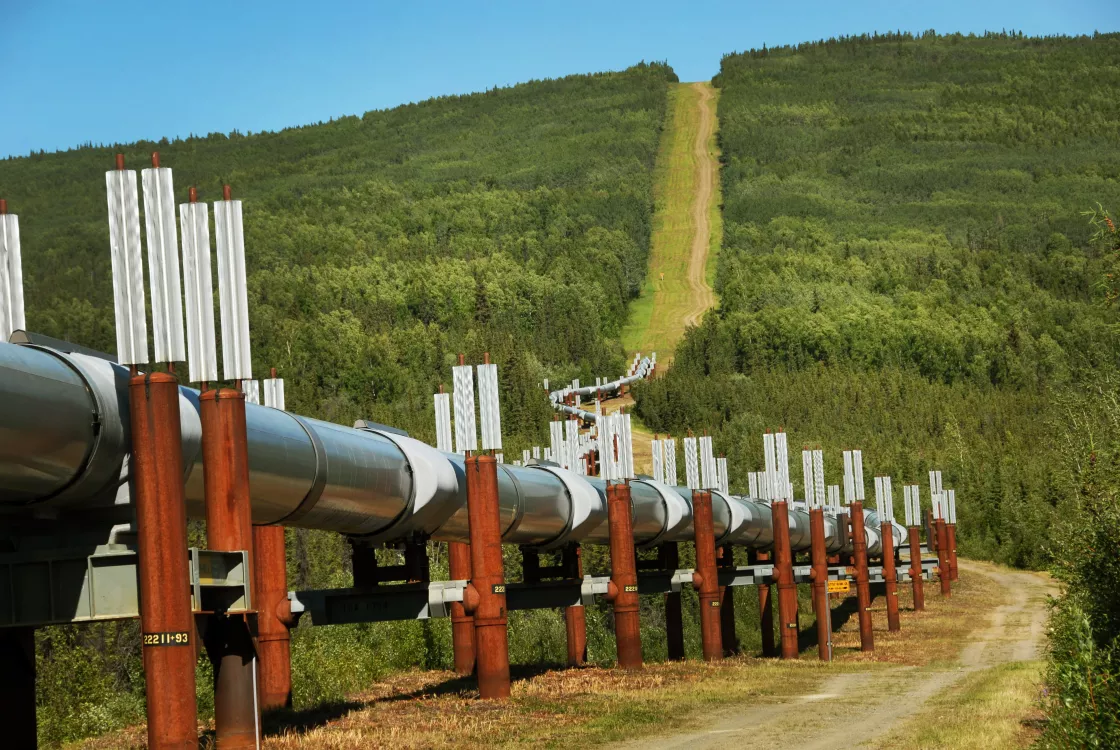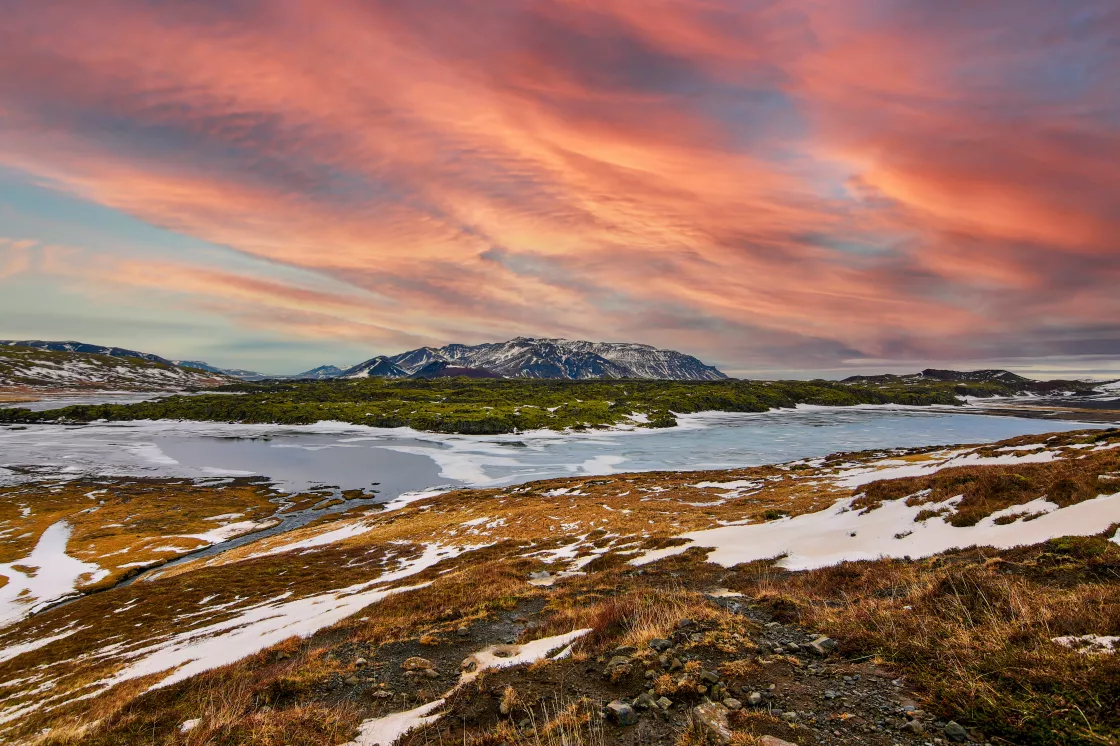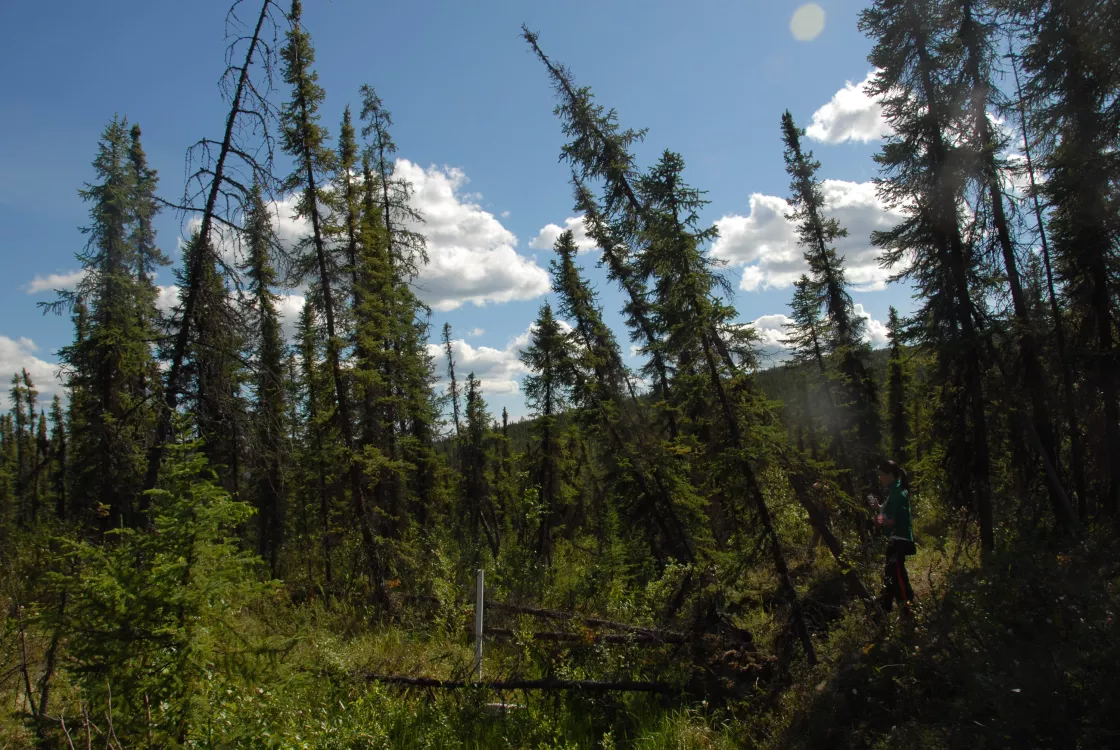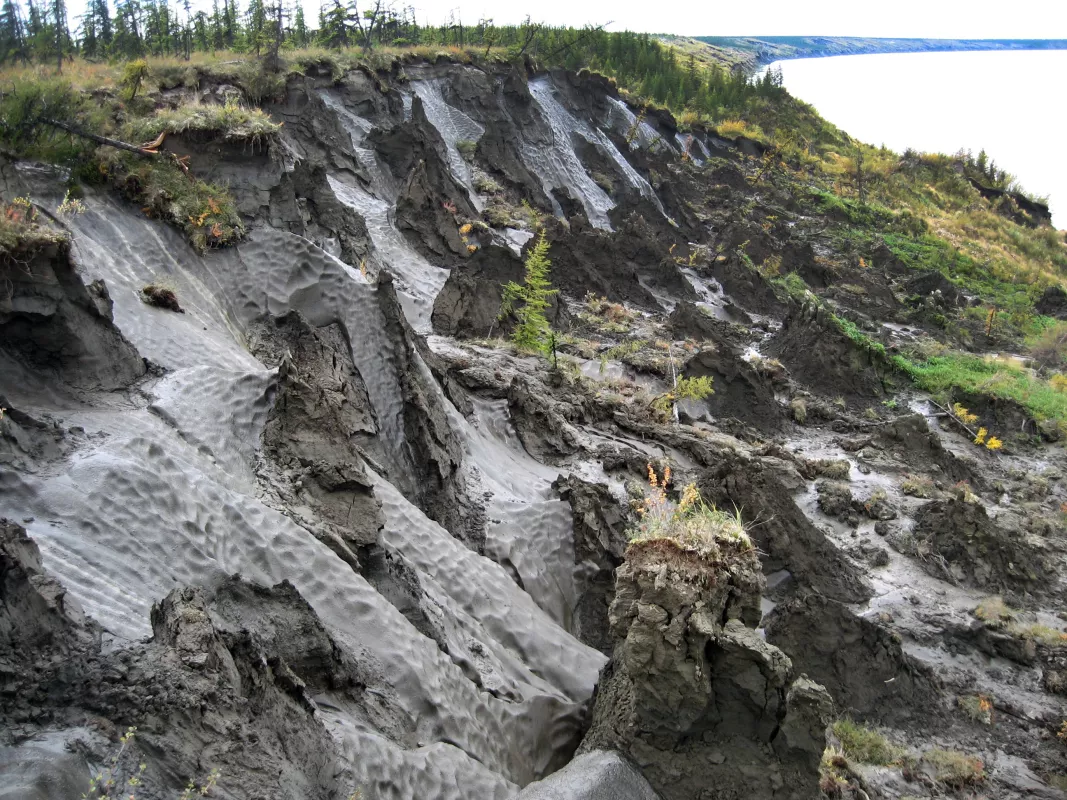Frozen Ground & Permafrost
Why it Matters
Since permafrost contains lots of organic matter like frozen plants and, occasionally, animals within, it holds an enormous amount of carbon. The Arctic contains nearly one-third of Earth's stored soil carbon in frozen ground and permafrost. If it thaws, microbial activity will lead to a release of heat-trapping greenhouse gases, carbon dioxide and methane, to the atmosphere. As of 2020, estimates suggest as much as 2.5 times more carbon is locked within permafrost than there is in the global atmosphere. Loss of permafrost may radically change the water and carbon cycle, significantly affecting climate change through feedback.
Methane is a much more potent greenhouse gas than carbon dioxide, although it does not remain in Earth's atmosphere as long. Once the organic matter within these landscapes decomposes and releases these greenhouse gases into the atmosphere, there is no putting them back.
Permafrost also lies beneath the Arctic Ocean, known as submarine or subsea permafrost, where vast reserves of geological methane are hibernating in an icy form known as methane clathrates. Scientists are concerned that, as the subsea permafrost thaws, this geologic methane could be quickly released to the atmosphere.
Although permafrost can be thousands of years old, it is sometimes newly formed or about to thaw, and it often exists close to the melting point, making it particularly sensitive to even minor increases in temperature. In the case of subsea permafrost, changes in ocean temperature can lead to thawing. So despite its name, instability is a part of permafrost.
In some areas, permafrost contains up to 80 percent ice. When this ice melts, the ground can collapse. This jeopardizes structures, triggers landslides, and feeds climate change feedbacks. Knowing where permafrost lies influences how buildings, roads, and other structures need to be built. For instance, the Trans-Alaska Pipeline System has 676 kilometers (420 miles) of above ground segments, where permafrost lies. As frozen ground thaws, pipelines, buildings, roads, airports, and factories are likely to be vulnerable to structural damage, requiring significant investments in repair and maintenance. Understanding permafrost, therefore, is important to civil engineering and architecture.
It also determines the way of life for many communities from building cool cellars to store perishable food to how resources are delivered to those living in the Arctic and beyond.
Carbon sink or source
Plants consume carbon dioxide through photosynthesis. So, a greater supply of carbon dioxide has the potential to boost plant growth—particularly with extended growing seasons and shrinking permafrost in the Arctic. Some climate projection studies suggest that carbon dioxide released by thawing permafrost will be at least partially offset by increases in productivity of Arctic plants. But unlike model projections, a survey conducted in 2016 of 98 permafrost-region experts concluded that plants will not come to the rescue. Water stress will hamper plant growth, and wildfires on boreal forest may cause a four-fold increase in carbon release into the atmosphere. As a result, Earth's permafrost will likely become a carbon source rather than a carbon sink by 2100. Some recent studies suggest that this has already happened.
Frozen ground and wildlife
Animals living on frozen ground face special challenges: Food is limited, water is frozen, and the weather is extreme. Yet, animals thrive in these ecosystems. During winter, some animals migrate to places with easier living conditions, while others hibernate and sleep the season away in warm burrows. Some are so well adapted to the cold that they remain active throughout the winter.
For example, the Arctic fox lives comfortably in areas with frozen ground. Like squirrels, the Arctic fox stores food such as bird eggs in the permafrost during summer. The eggs remain edible for up to a year. During the winter, the fox always has something to eat, even when the fox's favorite food, the collared lemming, is not available. The Arctic hare has also adapted. The Arctic hare does not build burrows underground, but rather builds its shelter in grass nests high up among rocks. Many insects, including mosquitoes, survive temperatures below freezing in regions of permafrost.
With the arrival of spring, melted snow and rain pools on the surface of permafrost, forming bogs, marshes, and wetlands. Slow-moving and standing water are ideal breeding grounds for mosquitoes. The flat interior and south-central Alaska, for instance, is notorious for swarms of mosquitoes so thick they appear as dark clouds. Only females suck blood to nourish their eggs. A swarm of mosquitoes can siphon a quart of blood per week from hoofed animals like caribou, musk oxen, and reindeer. They can kill caribou calves and even adult caribou. Caribou are said to be always roaming, trying to escape the mosquitoes. Flies, deer flies, and tiny biting midges also breed in the marshy swamps above the permafrost. These insects are also important food for birds, but like mosquitoes, can also make life uncomfortable for animals and humans.
After lying dormant through the winter, mosquito eggs hatch when waters become warm enough. Their wiggly larvae are a great food source for birds. However, as the Arctic continues to warm, mosquitoes hatch earlier and grow faster, avoiding the vulnerable state as bird prey. With lifecycles and migrations going out of sync, birds are missing the chance to feast on larvae. Therefore, climate change may boost mosquito populations in the Arctic.
The caribou, related to deer and other hoofed animals, travel hundreds of miles to forage on the grasses and other foods found in the bogs and marshes. In the treeless tundra, caribou raise their calves safely, away from the predators that need cover to hunt. Predators can still hunt the caribou, but they are less successful than if they had places to hide and stalk the caribou.
Brown bears, which include the famous and fearsome grizzly bear, are some of the Arctic's best-known large mammals. Brown bears fill up on food in the summer and fall to prepare for hibernation in the winter, sleeping for several months. This helps them conserve energy during the long winters, when food and water are scarce in permafrost and frozen ground habitats. If high latitude ecosystems change the timing of spring because of earlier and higher temperatures, brown bears may miss out on early spring food.
Frozen ground and people
People living in the Arctic have adjusted to life with permafrost. Generations in Alaska and Russia have stored their food in permafrost. Building such an underground refrigerator is no small task since the frozen ground is as hard as concrete.
Thawing permafrost has tangible, often visible, and potentially dangerous effects. When the ground beneath turns to a soggy, muddy mess, buildings tilt, roads buckle and dip, and other infrastructures become unstable. Roads, bridges, railroads, pipelines, and other types of transportation infrastructure are vulnerable when permafrost thaws, needing constant repairs to keep them safe.
There are several ways to stop road damage. Engineers sometimes replace soil under roads with gravel so that water drains better and there is less frost heave. Builders can elevate structures above the ground surface. Experts recommend painting roads white to reflect more heat and keep them cooler. A cooler road surface helps prevent frozen ground from thawing underneath.
In some places with permafrost, the top layer of the ground thaws during the summer, but the water does not drain away. These wet areas are too marshy for roads. To solve this problem, people only drive in these areas during the winter. Engineers build ice roads on top of the frozen marshes. The ice on the roads is at least 100 centimeters (about 40 inches) thick. Trucks weighing up to 64 metric tons (70 tons) can drive (slowly!) across and haul supplies to mines and drill sites in northern Canada and Alaska. Ice roads are also built on frozen lakes for winter travel. In summer, the roads melt, so they must be rebuilt each winter.
For people living in the Tibetan Plateau in southwestern China, the high altitude makes travel difficult between cities in Tibet and other major cities in China. The only way to get to some parts of the Tibetan Plateau was once to fly.
In 2006, to link Lhasa, the capital city of Tibet, with China, the Chinese government opened the Qinghai-Tibet Railway, the world’s highest train route, reaching altitudes over 5,000 meters (16,400 feet). The railway line, which cost US$4.2 billion to build, required designers and engineers to tackle three main challenges during construction: the fragile ecosystem, the lack of oxygen, and permafrost. The railroad stretches 1,100 kilometers (684 miles), nearly the distance between New York City and Chicago. Of that distance, 960 kilometers (597 miles) sits at 4,000 meters (13,100 feet). Special construction methods had to be used to build on the permafrost, as running a railroad could create heat that would thaw the permafrost beneath, buckling its tracks.
To make sure that the ground stayed frozen, Chinese engineers used crushed rock to insulate the ground and built high bridges to keep the train tracks above the permafrost.
When ice forms, it expands. So, constructing infrastructure on frozen ground is difficult. For instance, frost heaves lift the ground and everything on top of it. Also, the heating systems within buildings can potentially thaw the ground beneath the building. This would cause the ground to sink.
Engineers sometimes solve this problem by preventing the ground under the building from getting warm. They put the building on top of a steel frame, a few feet above the ground, so cold air can flow under the house. The cold air stops the permafrost from thawing. Another way to stop damage from thawing permafrost is to thaw the ground first. This method makes the ground more stable to build on. Then there is no danger of the ground beneath the new structure refreezing because the structure keeps the ground from freezing.
Frozen ground and drinking water
In areas with seasonally frozen ground, the groundwater under the surface usually does not freeze, making drinking water accessible. Plus, lakes, rivers, and reservoirs can provide water.
Permafrost, however, is more challenging as most of the groundwater is frozen. Typically, any water that is liquid may not taste good. The ice in the soil pushes its minerals out. These minerals get concentrated in any liquid water in the soil, affecting the taste of the water. In places of discontinuous permafrost, people do find water. They drill through areas of unfrozen ground to get to the groundwater.
In places with large, continuous stretches of permafrost, finding water takes a lot of effort. People can sometimes get water from nearby lakes and rivers or by melting ice or snow, but they cannot get liquid water directly out of the ground in the winter.
Some towns build water pipes from the water supply to the buildings. However, the pipes have to be protected so that water inside the pipes does not freeze, and so that the ground around the pipe does not thaw. Sometimes, engineers avoid this problem by building pillars to keep the protected pipes above ground.
Permafrost effect on oil and natural gas
Alaska, Canada, and Russia all have important deposits of oil and natural gas that give our cities, towns, and farms energy. Getting oil and natural gas out of the ground and to the people who use it is a huge effort.
Drilling deep wells for oil and gas can thaw permafrost. If the permafrost thaws, the wells can collapse. Drilling companies put their equipment on special concrete pads built to prevent the ground underneath from thawing. Concrete well liners prevent wells from collapsing. Companies also use special drilling liquids that do not freeze as quickly as water does to lubricate the drill bits.
Once the oil or gas is out of the ground, companies need to move it to where it will be used. In 1977, oil companies built the Alaska Pipeline. The pipeline takes oil 1,299 kilometers (800 miles) through Alaska to the shipping port of Valdez.
Building the Alaska Pipeline across permafrost required special consideration. Oil in the pipeline must be kept above 60°C (140°F) so that it flows easily. The oil would be warm enough to thaw the permafrost and cause the pipeline to sink and break, so engineers built the pipeline above the ground in areas of permafrost. The pipeline can run underground in sections that go through seasonally frozen ground. They also constructed devices to put the extra heat into the air rather than letting it go into the ground.
Frozen ground and the environment
Plants can grow in extreme conditions, including frozen ground. Plants need sunlight, nutrients from the soil, and water to live. In some places in the Arctic, the ground is frozen most of the year, and months go by without any sunlight. So, how do these plants survive?
Plants living in these areas must survive the winter with little water. They push their roots deep down under the frozen topsoil to find liquid groundwater. Plants that grow on seasonally frozen ground can grow quite tall because under the layer of frozen ground, the deep soil layer can support them.
When snow melts and seasonally frozen ground thaws in the spring and summer, bogs can form. Trees thrive in the rich, moist soil. In the Arctic, huge forests cover areas of seasonally frozen ground. The forests are called boreal forests. Sometimes they are called taiga, the Russian word for swampy, moist forest.
Typically, trees in the boreal forest are conifers. Conifers have small needle-like leaves that may have a waxy coating. Confers save water because their leaves do not have much surface area. For example, an oak leaf is broad, thin, and delicate, with a large surface area, causing much more water loss from transpiration than thin pine needles. By conserving water, conifers do not need to get as much water out of the ground.
Surviving in permafrost, rather than frozen ground, is a much larger challenge for plants. On top of extremely low air temperatures and frozen water, permafrost contains only a thin layer of topsoil.
Tundra is a type of biome where low temperatures, short growing seasons, and larger stretches of permafrost hinder tree growth. The word tundra is a Finnish word referring to a treeless plain. Tundra is found at high latitudes and at high altitudes, where the permafrost has a very thin active layer that cannot support a tree's roots. Tundra areas are some of the coldest and driest on Earth. Strangely, even though the tundra does not get much rain or snow, it often has many shallow lakes and ponds, wetlands, and swamps during warm seasons. This is because permafrost acts like a barrier, preventing water from draining through it. The grasses, lichens, and shrubs that do grow on the tundra make a thick and colorful carpet.
Not all permafrost is tundra. Boreal forests do sometimes move into areas where areas of permafrost are mixed with seasonally frozen ground.
The plants of the tundra and the permafrost underneath are in balance. Plants growing on the surface absorb solar energy, protecting the permafrost and preventing it from thawing. The permafrost keeps melted water near the surface, where plants need it.
However, this balance is fragile. If the plant cover is damaged, the permafrost can thaw. Thawing permafrost can make the ground collapse and disturb and deepen the active layer. This can also affect the plants and animals that have lived there for many years.
If the permafrost is damaged, plants also suffer. Fires, floods, or unusually high temperatures can thaw it. Trees growing in boreal forests are threatened. Sometimes, their roots become so weak that trees tilt and fall over, known as a drunken forest because of how trees topple onto one another.
Impacts of climate change on permafrost
As Earth's climate warms, permafrost and frozen ground thaw, shrink in their extent, and/or disappear entirely. In the Northern Hemisphere, the amount and thickness of seasonally frozen ground is decreasing. Above permafrost, the active layer, where the ground freezes and thaws each year, is getting thicker, meaning the permanently frozen ground layer is thinning. In Russia and China, scientists have found that the active layer has become much thicker since the early 1980s:
- In Siberia, it is up to 25 centimeters (10 inches) thicker.
- On the Tibetan Plateau, it is up to 100 centimeters (40 inches) thicker.
The Arctic Report Card: Update for 2017 reported continued increases in active layer thickness since the 1990s, at sites measured in North America, Eurasia and Greenland.
Likewise, more pockets of unfrozen ground known as taliks are forming within frozen ground. Eventually, very little permafrost may be left, depending on the degree of warming. Likewise, seasonally frozen ground and permafrost areas will not reach as far south as they do now in the Northern Hemisphere. As the active layer becomes thicker, the landscape may change. The ground can become weak. In hilly areas, thawing can cause landslides. In some areas, thawing changes the landscape, creating slumping ground, unstable forests, and shallow lakes. These landforms are examples of thermokarst features.
Scientists have found that there is now 10 percent less frozen ground in the Northern Hemisphere than in the early twentieth century. Ten percent equals more than 5 million square kilometers (2 million square miles), about two-thirds the size of the continental United States.
As of 2021, Earth has warmed about 1°C (1.8°F) since preindustrial levels. A 2017 study suggests that with every additional 1°C (1.8°F) warming, another 4 million square kilometers (1.5 million square miles) of permafrost will disappear. This is about 20 percent higher than previous studies, according to the scientists.
The study also states that under a business-as-usual greenhouse-gas-emission scenario, which would result in a 6°C (10.8°F) warming sometime after 2100, nearly all of Earth’s permafrost would likely disappear.
All of these changes will affect how plants grow, and how carbon and water will cycle through the environment. Without permafrost, water will drain away or evaporate into the air. Wetlands will dry up. Fewer plants will grow, and with reduced resources, fewer animals will be able to survive. People may also find it harder to find water and food in regions where permafrost has disappeared. Moreover, the increased abundance of greenhouse gases into the atmosphere will only exacerbate warming and continue permafrost thaw.
Warming leads to cascading impacts on arctic land animals. Swedish Saami, a group known for reindeer herding, have observed that since the mid-1990s thawing frozen ground in summer grazing areas, leads to soggy falls and rotten spring vegetation.
Permafrost thaw, erosion, and community collapse
About 500 people live in Shishmaref, a small town on a barrier island near the Bering Strait, just below the Arctic Circle. The island is only about a quarter of a mile wide, and it is shrinking. The Iñupiaq people lived nomadic lives in the area for thousands of years until the government forced them into stationary lives. Then, they witnessed as their town started to literally fall into the sea.
Shishmaref lies on a permafrost island along the coast of the Bering Sea. In the past, the ground stayed frozen, and sea ice hugged the shores. Sea ice protected the shore from waves even in the summer. However, since the 1980s, summer sea ice has become much more unpredictable, with the summers of 2018 and 2019 setting record lows for the region. Now, waves batter the shoreline in summer, washing away the coastline. Every year, about 7 meters (23 feet) of Shishmaref washes into the sea.
The people of Shishmaref have moved their buildings away from the shore, put rocks and sandbags down to protect the coast, and built seawalls. But the waves are still washing the land away. Villagers have voted three times to relocate: in 2016, 2002, and as far back as 1973. Though in 1973, climate change was not yet at the forefront, worries about erosion were already evident, only to accelerate a few decades later. Though Shishmaref and other towns have been engaged in plans to move, moving an entire community is complicated and costly. According to one report put together by the US Army Corps of Engineers, the cost of moving Shishmaref would be somewhere around $179 million.
The deep thaw: what’s locked within?
Mammoth bones are surfacing in the Russian Far East—so many that people have begun selling the tusks as a substitute for elephant ivory.
Permafrost thaw has far-reaching consequences for all life on the planet, including humans. Just like thawing meat out of your freezer begins to rot after a few days, so does the organic matter trapped within frozen soil. Rising soil temperatures activate the microorganisms once frozen within. Once turned on, they degrade the plant and animal matter within the soil, releasing loads of carbon and methane and intensifying global warming.
Right now, Earth's atmosphere contains about 850 gigatons of carbon. A gigaton is one billion tons—about the weight of one hundred thousand school buses. Scientists estimate that there are about 1,400 gigatons of carbon frozen in permafrost. That means that permafrost holds 2.5 times the carbon that is currently in the atmosphere. Once released, a cycle ensues of warming soil, increasing heat-trapping gasses into the atmosphere, and raising global temperatures.
Scientists are still studying the amount of carbon stored in permafrost and how quickly it might break down. For example, scientists found a type of permafrost that is rich in matter from dead plants and animals, called yedoma. Yedoma is a type of relict permafrost, left over from the Pleistocene epoch. It mostly exists in Siberia in northern Russia. If all yedoma were to thaw, it could release a very large amount of carbon to the atmosphere.
Harmful once-frozen bacteria wake with the thaw. In 2016, in remote Siberia on the Yamal Peninsula, a 12-year-old boy died of an unknown disease. One hundred other people were hospitalized, 20 were diagnosed with the same disease, and more than 2,300 reindeer were found dead. According to Russian officials, thawed permafrost was the cause. Previously immobile spores of Bacillus anthracis seeped out of the thawing ground and into nearby waters and soil, and down into the food supply. Anthrax infection typically attacks livestock and wild animals. Usually, anthrax bacteria enter the body through a wound in the skin. A person can also become infected by eating contaminated meat or inhaling the spores. Inhaled anthrax is more difficult to treat and can be fatal.
Researchers have predicted that higher temperatures, combined with permafrost thaw, could trigger the release of dormant diseases. As warming increases, the spread of thawing permafrost likewise increases. The release of dormant diseases depends on several factors:
1. Where the pathogens are located in terms of permafrost depth and global location
2. How high temperatures rise
3. And the strength of pathogen variants
For instance, not all pathogens can survive extremely cold temperatures. Anthrax, however, can. It is possible that viruses once thought to have been eradicated by humans could return on a large scale, like smallpox or the Spanish flu.
A 2014 study showed how two scientists resurrected a virus from a 30,000-year-old piece of ice in Siberia. Although this very large virus targets amoebas, it was still infectious after all that time. The two scientists attempted to revive this virus after learning about Russian scientists who successfully grew an ancient plant from 30,000-year-old seeds. Ground squirrels buried a hoard of fruits and seeds, and the permafrost encapsulated them. In 2012, when the plant was resurrected, it was the oldest living plant ever revived.
Mercury rising: thawing permafrost
Researchers have discovered that thawing permafrost in the Northern Hemisphere traps another by-product of decaying matter. Mercury naturally occurs in the Earth’s crust and typically enters the atmosphere through volcanic eruptions. The element cycles between the atmosphere and ocean quickly. However, mercury deposited on land from the atmosphere binds with organic matter in plants. After the plants die, soil microbes eat the dead organic matter, releasing the mercury back into the atmosphere or water.
In permafrost regions, however, the organic matter gets buried by sediment before it decays and becomes frozen into permafrost. Once frozen, the decay of organic matter stops, and the mercury remains trapped for thousands of years unless liberated by permafrost thaw.
As long as the permafrost remains frozen, the mercury will stay trapped in the soil. However, with global temperatures rising, this seems unlikely.
In a 2018 study, scientists measured mercury concentrations in cores of permafrost from Alaska. They used the data to estimate how much mercury has been trapped in Northern Hemisphere permafrost since the end of the last Ice Age about 12,000 years ago.
Apparently, Northern Hemisphere permafrost regions contain 1,656 gigagrams of mercury (32 million gallons), or enough to fill 50 Olympic-sized swimming pools. These regions are the largest known reservoir of mercury on the planet. This amount is nearly twice as much mercury as all soils outside the northern permafrost region, the ocean, and the atmosphere combined.
The researchers also found that of the 1,656 gigagrams of mercury, 863 gigagrams lie in the surface layer of soil that freezes and thaws each year (27 Olympic-sized swimming pools), and 793 gigagrams are frozen in permafrost (23 Olympic-sized swimming pools).
The finding has significant implications for human health and ecosystems worldwide. For instance, once mercury is released because it is concentrated in these areas, it would pollute rivers, groundwater, and all life that depends on this water.
In 2020, a NSIDC researcher published a study stating that the concentration of mercury in fish in Alaska’s Yukon River may exceed the Environmental Protection Agency’s mercury criterion by 2050. This first-of-its-kind research estimates potential releases of mercury from thawing permafrost in high and low greenhouse gas emissions scenarios. The researchers predict that by 2200, the mercury emitted into the atmosphere annually by thawing permafrost could compare with current global anthropogenic emissions under a high emissions scenario.
The results indicate minimal impacts to mercury concentrations in water and fish for the low emissions scenario and large increases for the high emissions scenario. The high emissions scenario shows mercury releases to the atmosphere comparable to current anthropogenic emissions, with large increases in mercury concentrations in fish and water in the Yukon River. The low emissions scenario shows minimal releases to the atmosphere and small changes to mercury concentrations in fish and water. For the high emissions scenario, mercury concentrations could double in the Yukon River by 2100. For the low emissions scenario, mercury concentrations would likely increase by only about 14 percent and would not exceed EPA criterion by 2300.
Methane: the other greenhouse gas
Methane is a gas made up of one carbon atom and four hydrogen atoms. As organic matter decays, microbes digest it and produce either carbon dioxide or methane as waste. If there is oxygen available, the microbes make carbon dioxide. But if there is no oxygen available, they make methane. Most of the places where methane would form are swamps and wetlands. And many miles of wetlands are in the Arctic. When walking around in the Arctic tundra in the spring or summer, it is like sloshing through a giant sponge. When permafrost carbon turns into methane, it bubbles up through soil and water. On the way, other microorganisms eat some of it. But some methane makes it to the surface and escapes into the air.
Like carbon dioxide, methane is a greenhouse house with heat-trapping properties. Methane lingers in the air about a decade on average, which is much less time than carbon dioxide, but it traps much more energy too. According to the US Environmental Protection Agency, methane is between 28 to 36 times more efficient at trapping heat than carbon dioxide over a 100-year period—the time period used for comparing different gases and their global warming potential. To put it simply, methane is much more powerful than carbon dioxide at warming the climate but breaks down faster.
Human activities are responsible for about 60 percent of methane emissions. Methane seeps out during the production, processing, storage, transport, and use of coal, natural gas, and oil. It is the primary component of natural gas, used to heat many homes. Methane also enters the atmosphere through agriculture (including fermentation, manure management, and rice production), landfills, and wastewater treatment.
There are two potential sources of methane in the Arctic. The first is called methyl clathrate. Methyl clathrates are methane molecules that are frozen into ice crystals. They can form deep in the earth or underwater, but it takes very special conditions, with high-pressure and low temperature, to make them. If the temperature or pressure changes, the ice that locks in the methane will break apart, and the methane will escape. Scientists are not sure how much methane is trapped in methyl clathrates, or how much is in danger of escaping. Estimating methane release from clathrates under the Arctic’s subsea permafrost is an active area of research.
The other major source comes from thawing dead plants and animals that have been trapped in the frozen permafrost for thousands of years. As long as this organic matter remains frozen, methane will not escape. However, when permafrost thaws, the organic matter decays, releasing carbon dioxide and/or methane into the atmosphere.
Thawing permafrost and sea level rise
If all the permafrost in the world thawed, it could release enough water to raise global sea levels by 3 to 10 centimeters (1 to 4 inches). This might not seem like very much water, but it is enough that many cities along coastlines would need to build walls to keep the sea out.
Both model projections and observations have pointed to current and future permafrost degradation. A study published in 2005 suggests that by 2100, as little as 1.0 million square kilometers (386,000 square miles) of near-surface permafrost might remain, increasing the freshwater discharge from rivers into the Arctic Ocean by 28 percent. This projection applied only to the top few meters of permafrost and depended upon climate and snow cover models. A 2022 study examining climate model output corroborated the general projection of the 2005 study: widespread permafrost loss by 2100.
Field observations indicate that permafrost warmed up to 6°C (10.8°F) during the twentieth century. In January and April 2006, air temperatures on Svalbard reached more than 12°C (21.6°F) above the 1961 to 1990 average. On June 30, 2021, the temperature at Fort Smith, Northwest Territories, Canada, reached 39.9°C (103.8°F), a heatwave that could have broken records at much lower latitudes.
Observations in Alaska found permafrost warming at most sites north of the Brooks Range from the Chukchi Sea to the border with Canada, coincident with statewide air-temperature warming beginning in 1976. The warming occurred primarily in the winter, with little summertime change.

